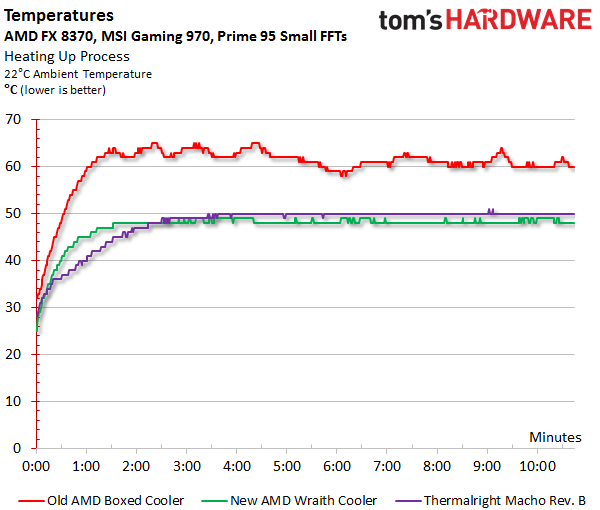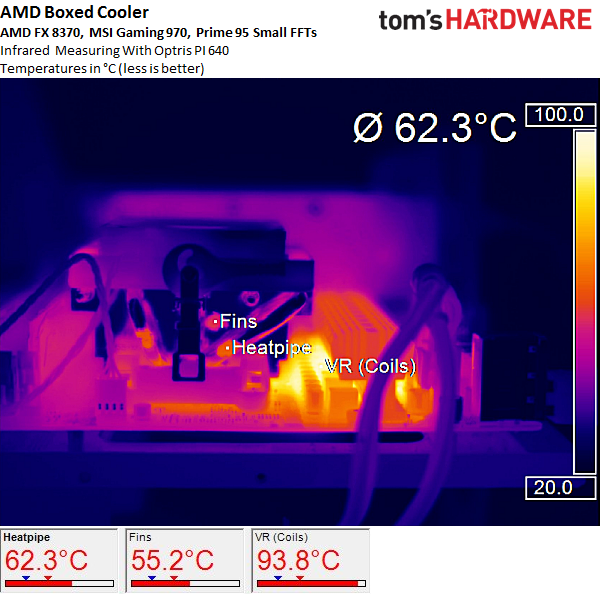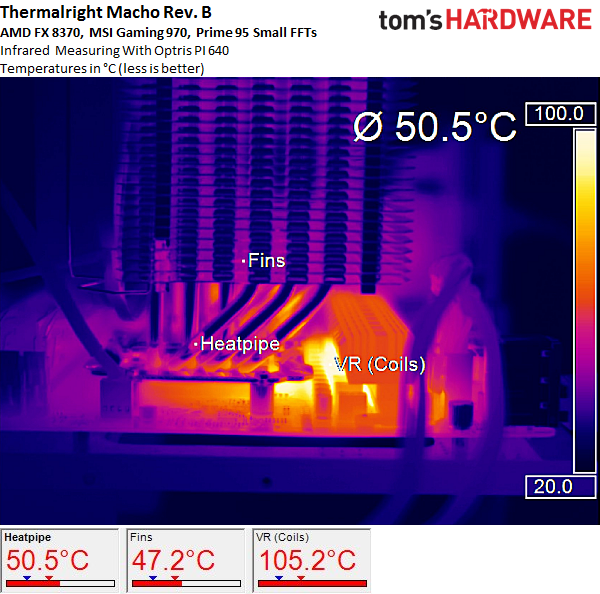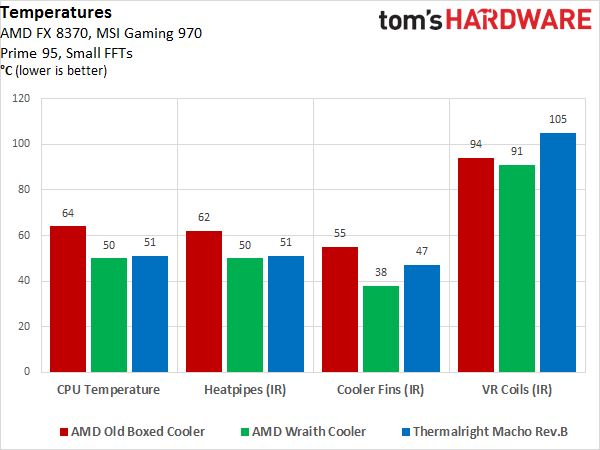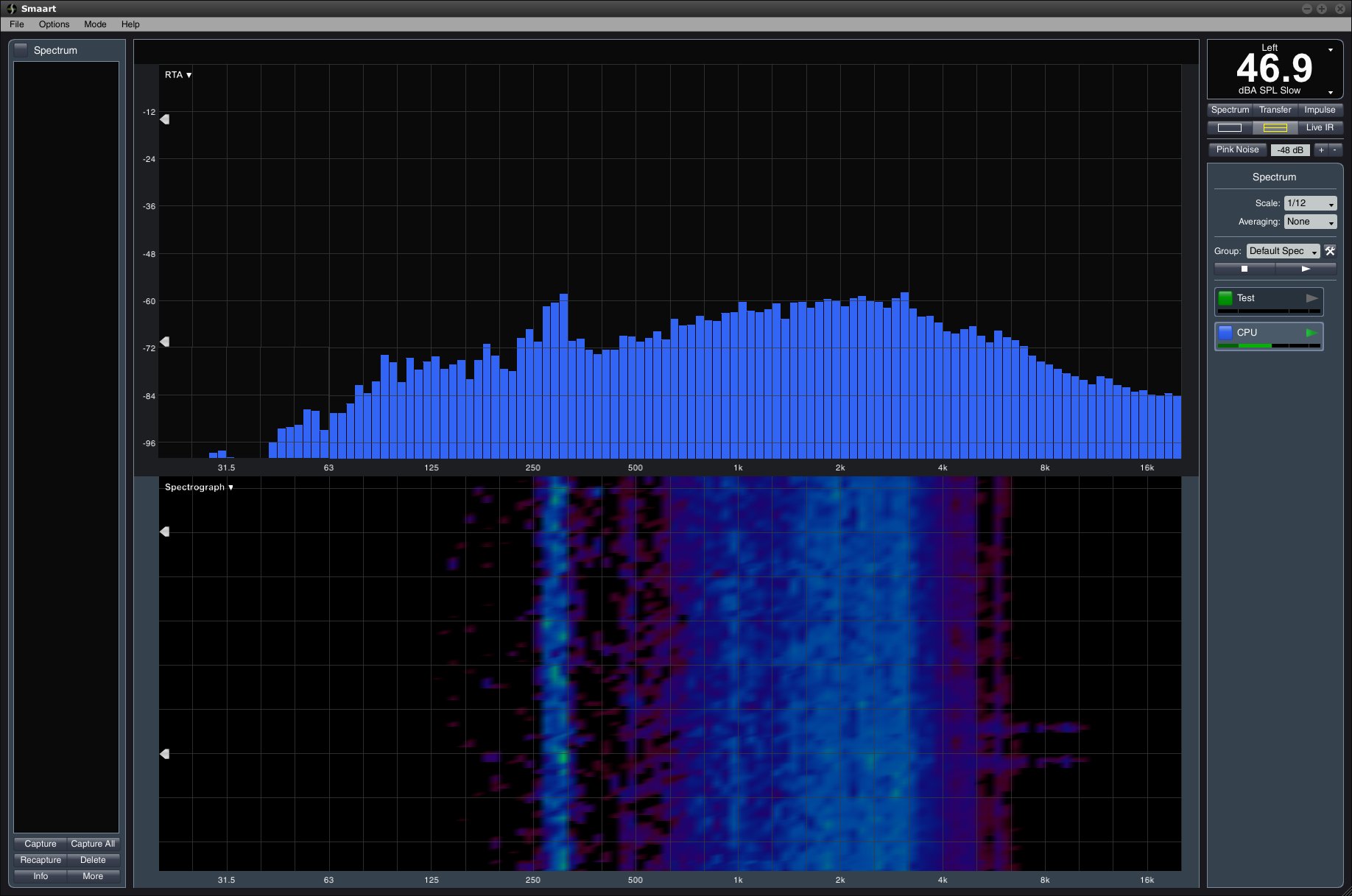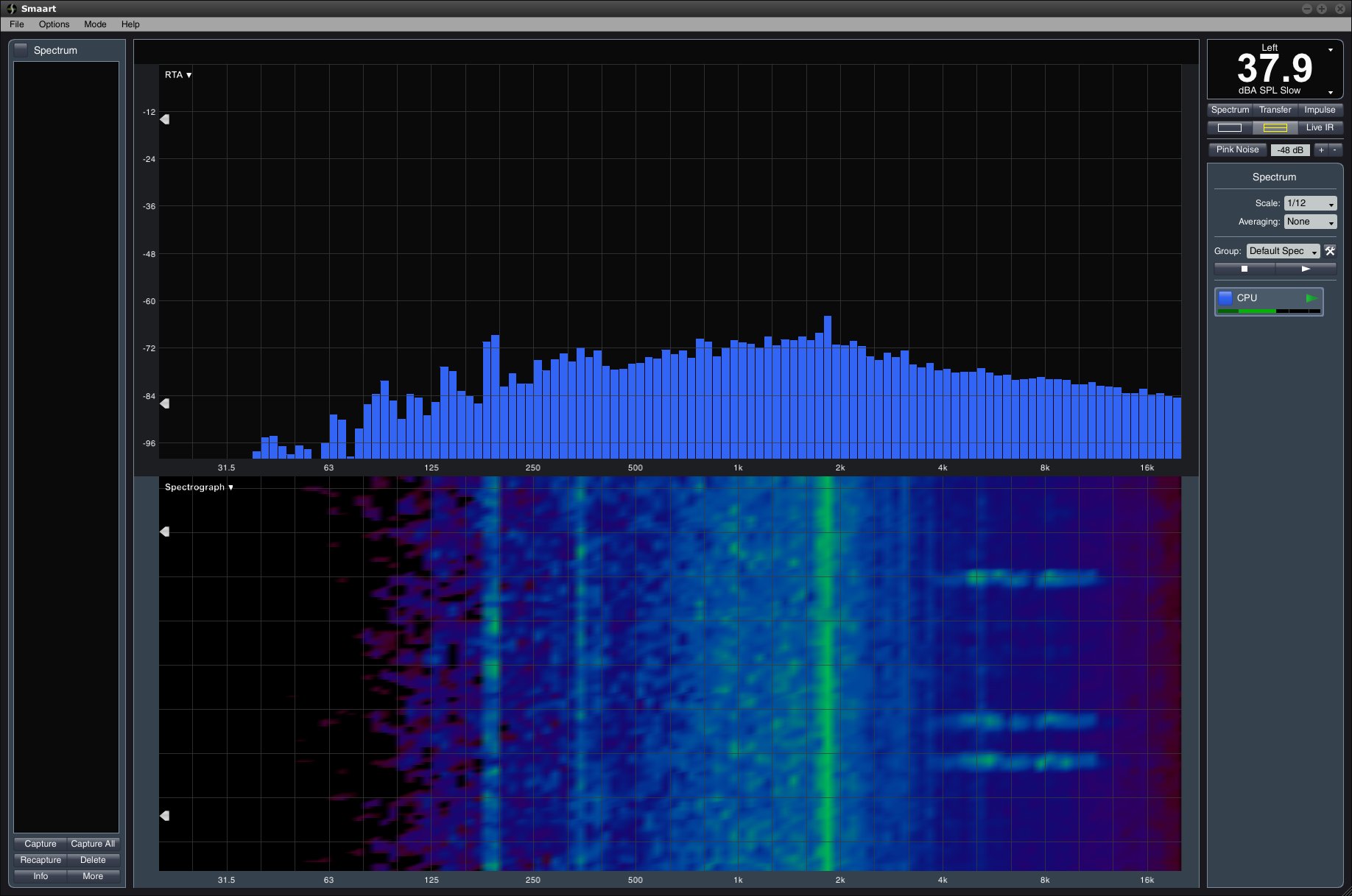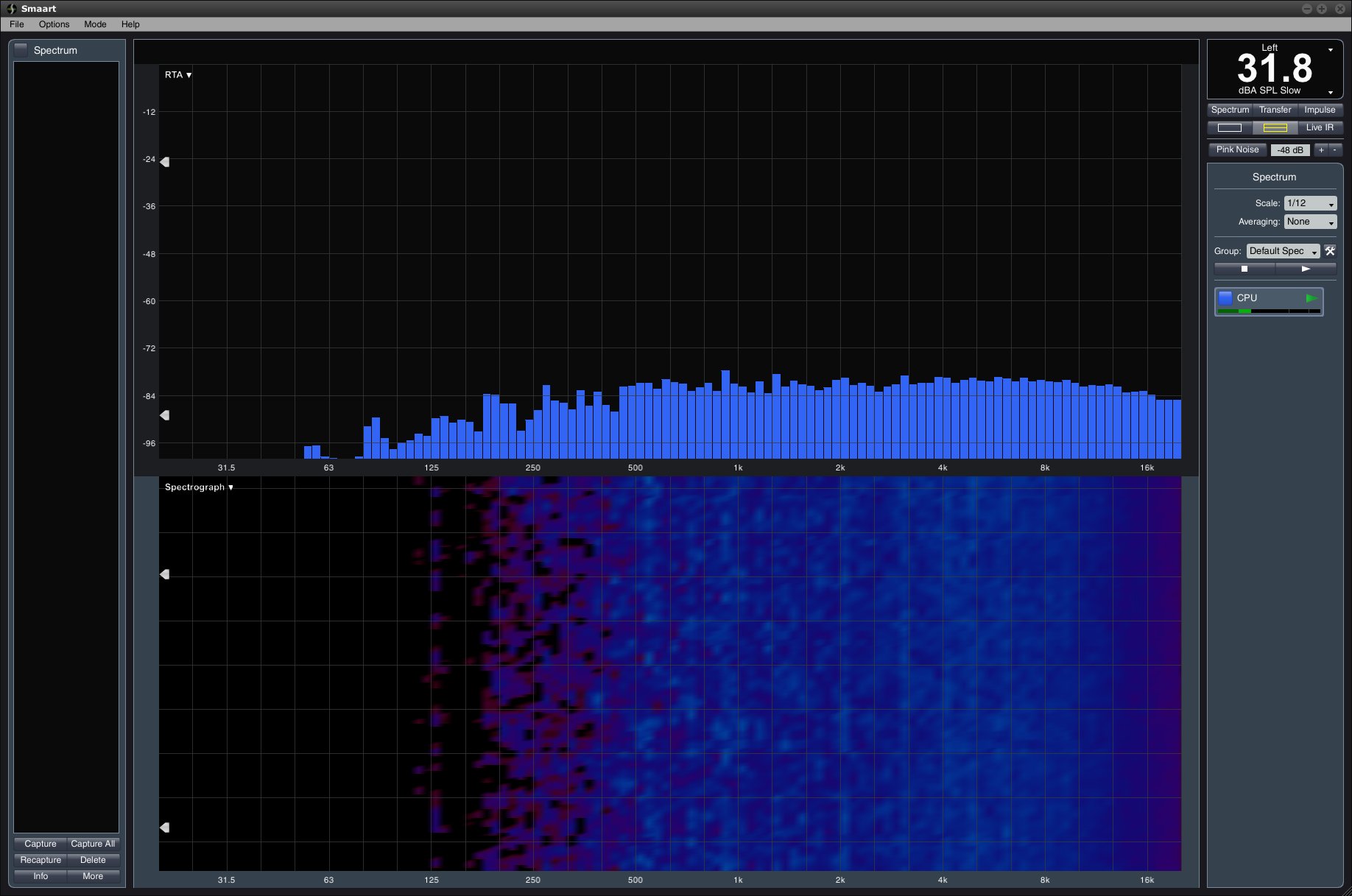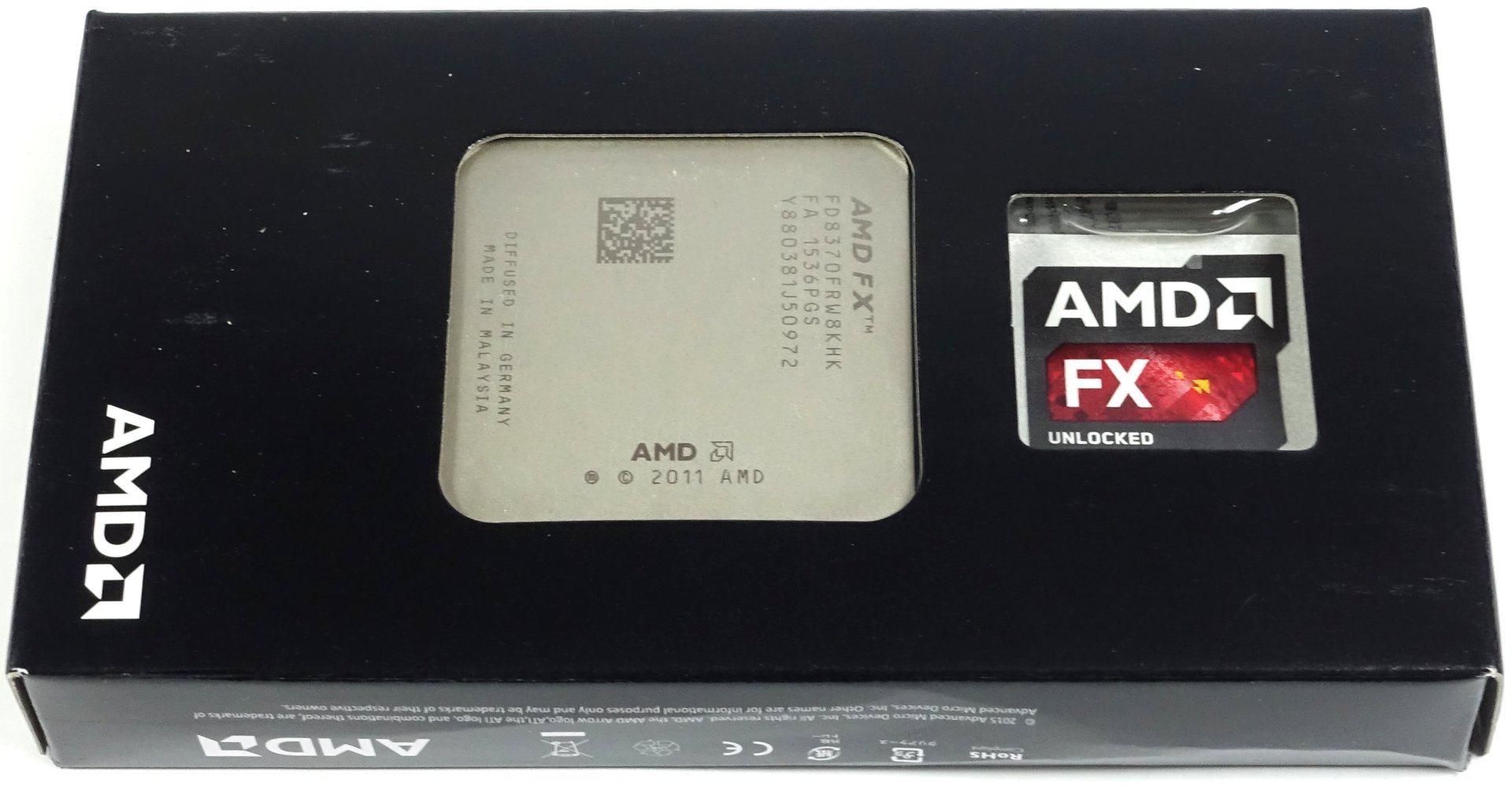AMD Wraith CPU Cooler Review
Never has a stock CPU cooler garnered as much attention as AMD's Wraith. Manufacturers usually don't even mention these bonus items, but AMD's new CPU cooler has changed all of this. Is the Wraith really a game changer?
Temperatures, Noise And Conclusion
Temperatures
Before we get to the final temperatures, we look at the warm-up phase, which only lasts a few minutes for all of these CPU coolers. The ambient room temperature was held at the same steady 22 degrees Celsius during all tests, which makes the results comparable. AMD's Wraith and Thermalright's Macho Rev.B achieve almost identical temperatures when the BIOS fan control is left at its default 50 degree Celsius target. The smaller Wraith gets warm more quickly than the significantly larger Macho, of course.
AMD's old stock cooler is a good example of cutting corners. The board has trouble keeping things steady, since there's just not enough cooling performance to stabilize on a setting. Consequently, it has to really push the fan all the way to its maximum to get things back under control when the processor reaches its maximum temperature. The 64 degrees Celsius result that we measured on the heat spreader is just too much.
In order to gain a better understanding of what exactly is going on here, we're comparing infrared measurements of all three CPU coolers. We're starting with the old stock cooler. For the following results, all desired measurement locations were coated with a calibrated lacquer to guarantee accurate readings.
A whopping 62 degrees C measured at the heat pipes is simply too high; the small CPU cooler just can't deal with this amount of thermal energy. Approximately 2 degrees C difference between the heat pipe and heat spreader is a testament to the poor quality of AMD's old stock cooler. The 93 degrees C measured right next to the voltage converters isn't great, but it's acceptable.
The Wraith's results tell a different story. It stays significantly cooler, and the heat pipes and spreader achieve close to the same temperature. The outer cooling fins stay cooler, which is the result of the Wraith's larger size and better thermal performance. The top-down airflow design also helps cool voltage regulation-related components on the motherboard that aren't actively cooled. They reach a maximum of just 91 degrees Celsius.
Last and certainly not least is Thermalright's Macho Rev.B, which keeps the processor at about the same temperature as AMD's Wraith, but at a significantly lower rotational speed with its 140mm fan. For this reason, its fins stay a bit warmer, but Thermalright's CPU cooler's sheer size easily compensates. What's not as great are the component temperatures in the VR area of the motherboard. They are a massive 14 degrees C higher compared to the Wraith. Since some of the components in question are capacitors, these kinds of temperatures aren't acceptable over longer time periods.
This is generally a problem with tower coolers. Asymmetric designs, which are supposed to make the coolers compatible with taller RAM sticks, further exacerbate the issue. From this perspective, the Wraith actually cools better, since it cools the surrounding area on the motherboard in addition to the processor. In a closed case, this problem gets even worse, since the RAM sticks cut off any airflow below a certain point.
Get Tom's Hardware's best news and in-depth reviews, straight to your inbox.
Let's close this section with an overview of the temperatures of the different measurement areas after one hour of continuous operation. Do note, however, that these temperatures barely changed after the warm-up phase.
Fans And Noise
The Wraith's temperatures are right on target—we know this much from our measurements so far. Even if the Wraith can compete in the temperature arena, the question remains if this comes at the price of high fan speeds, which can lead to high noise levels.
Once again, it's easy to spot just how much the motherboard's fan controller has to work to keep the processor from frying with AMD's old stock CPU cooler. The Wraith's 1700 RPM results are decent, especially considering that its maximum is almost twice this speed at 3100 RPM. This means that it has enough reserves for some peace of mind and potentially provides a peaceful noise level as well. The Thermalright Macho Rev.B's fan plays in a whole other league with an almost inaudible 720 RPM.
We're going beyond subjective impressions, though, by using our test chamber, which we constructed just for this purpose. This is where we're conducting all of our audio and noise (graphics cards, case, etc.) measurements.
Noise Level And Frequency Spectrum
The total noise level is great for quick comparisons, but doesn't say a whole lot about the character of the noise. For this, the whole noise spectrum is needed, since it shows if there are peaks in particularly annoying frequency ranges.
Old AMD Stock CPU Cooler
Once again, we get going with AMD's old stock CPU cooler. Up to 4300 RPM leaves a very much audible mark. Apart from some bearing and clicking sounds at approximately 280 Hz, this CPU cooler makes a whirring and hissing noise that's just unpleasant, which makes it even more annoying than the noise level would indicate. Not that the overall noise level is good—between 45 and 47 dB(A) depending on the current state of the fan controller is just a really bad result.
AMD Wraith CPU Cooler
AMD's Wraith doesn't just subjectively sound quieter, it actually is more quiet. Unfortunately, the ball bearing does make a rattling noise that can be both subjectively heard and objectively seen in the spectrum graph without much effort. The 38 dB(A) that we measured are a good result. Even under full load, the Wraith just doesn't get that loud. The ball bearing of the inexpensive fan is the only caveat here.
Overall, this is a very solid result, especially since the cooler can't really be distinguished from the other noise sources in a closed PC case, as long as there are no passive components.
Thermalright Macho Rev.B CPU Cooler
Thermalright's Macho Rev.B plays in a different league. Its 32 dB(A) and very low-key frequency spectrum can attest to this. The results could have been even better, had it not been for the turbulence caused by the RAM sticks. On AMD motherboards, the Macho's body, which sits relatively close to the board, actually touches the RAM sticks, which consequently cuts off some of the airflow. Since Thermalright's Macho Rev.B isn't a high-end, but an upper-mid-level CPU cooler, the only possible conclusion to be drawn here is that AMD's marketing statements about the Wraith being the quietest CPU cooler in this price range are way too optimistic.
Conclusion
AMD's Wraith is a well-designed, nicely built and generally solid CPU cooler. To be fair, this means that it is in a league of its own when it comes to stock CPU coolers. In this context, we'll forgive the overly optimistic statements by AMD's marketing. In the end, the message does have a point: the company's Wraith might be louder than Thermalright's Macho Rev.B, but it also does a better job cooling the motherboard area around the processor.
So, AMD's Wraith isn't as quiet, but it does provide more cooling in certain areas. This is actually a great bottom line to write about a stock CPU cooler. After this move by AMD, things will never be quite the same in this arena, especially if the Wraith should gain traction in the market as a free add-on. The metal waste bins of many PC shops and builders could be looking forward to a lot more empty space, at least as long as the people in question are using AMD processors. And maybe, just maybe, this would force Intel's hand, and then the aftermarket CPU cooler industry would have a real problem. Only time will tell.
AMD's Wraith doesn't make the FX-8370 any faster, but because the price stays the same with the new CPU cooler included, it makes it more attractive. We'd say that it fits in the $20 to $30 category, which represents some nice savings for anyone who's buying a new processor and doesn't already own a suitable CPU cooler.
[Editor's Note: So far we haven't been able to find the FX-8370 with the Wraith at online retailers. AMD tells us the new parts should be available to North American retailers "shortly." When that happens we will update this piece to reflect that.]
MORE: Best Cooling
MORE: Best Liquid CoolersMORE: Best CPUs
MORE: All Cooling Content

Igor Wallossek wrote a wide variety of hardware articles for Tom's Hardware, with a strong focus on technical analysis and in-depth reviews. His contributions have spanned a broad spectrum of PC components, including GPUs, CPUs, workstations, and PC builds. His insightful articles provide readers with detailed knowledge to make informed decisions in the ever-evolving tech landscape
-
eklipz330 good work. however, if they expect to sell more processors because of this, they will surely be disappointed.Reply
good job noting the importance of top down coolers over tower coolers. -
Amdlova Please put in thest the old amd cooler with came with phenoms ddr2 i think its same cooler. good cooler btw, try overclock some to get it burn,Reply -
Calculatron I think the methodology and the data shown in this review makes it a great cooling review - I hope it sets a trend!Reply
I wonder how Crashman's old Thermalright MUX-120 might measure up? -
FormatC Reply17435232 said:Please put in thest the old amd cooler with came with phenoms ddr2 i think its same cooler. good cooler btw, try overclock some to get it burn,
The cooler is more or less the same. This model was built by AVC since the 125 watts FX 62 without major changes ;)
-
falchard Maybe people will buy the AMD CPU to cool their Intels. AMD should include an Intel adapter just in case.Reply
This review does bring some considerations towards cooling the motherboard. First it demonstrates how MSI gets its better performance, by allowing higher voltages and using higher quality capacitors. This is one of the reasons I love MSI, and one reason some MSI GPUs have burned. Second the big CPU coolers and liquid coolers don't adequately provide cooling to cheaper motherboard components. Higher end motherboards might be a different story with their large heat sinks. -
FormatC The heatsinks are only above the VRM. All things like coils or caps are not cooled. Take a look at our i7 5960X review and the IR pics and you know, what I mean ;)Reply
Scroll down to the video at the bottom:
http://www.tomshardware.com/reviews/intel-core-i7-5960x-haswell-e-cpu,3918-10.html
Heat is like a wave and soldered pins of caps are like antennas :D -
joshyboy82 Seems like this directly butts up against the Cryorig C7, which by my research does everything better. Also, if you have an Intel chip and are feeling left out by this new cooler, the C7 can massage your...worries.Reply -
FormatC The best replacement (temperatures, noise, price) is for me the Raijintek Pallas. But he has problems with higher RAM modules. The Wraith not :)Reply -
SuperVeloce "From this perspective, the Wraith actually cools better, since it cools the surrounding area on the motherboard in addition to the processor. In a closed case, this problem gets even worse, since the RAM sticks cut off any airflow below a certain point."Reply
This is actually not true if your case exhibit at least some airflow. Passive components will be better cooled in a good closed case rather than with open sides
